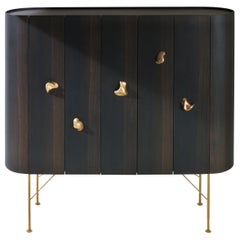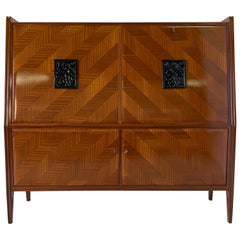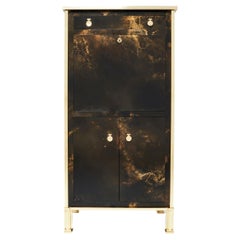Laurameroni Secretaires
Situated in the famous furniture manufacturing hub of Brianza, Italy, Laurameroni is an award-winning company that produces luxury tailor-made furnishings from the finest quality woods, marble, glass, and other meticulously handpicked materials. The atelier’s distinctive armchairs, table lamps, credenzas and other pieces are customized to meet the needs of interior designers, architects or private clients.
Laurameroni’s bespoke furniture began as a single collection in 1999 before it took shape as a brand founded by Massimo Maggioni in the spring of 2000, debuting at the International Furniture Fair in Milan.
Back then, the founder was adamant that the era’s economic fluctuations would not compromise the company's success — the quality of the handcrafted seating designs in woods such as Syberian ash and Stone oak or sleek lighting fixtures in black nickel-plated brass would speak for itself and propel the firm forward. A bit less than 20 years later, at the Design Shanghai exhibition in 2018, the BD13 cabinet by Bartoli Design perfectly epitomized what Laurameroni — at the time, a newcomer to Shanghai Design — is all about: luxe materials, interesting surfaces and creative craftsmanship. Its carved rosewood facade re-creates the random patterns found on the wooden platforms used by marble carvers during the cutting process.
Over time, Laurameroni has partnered with studios and designers such as Bartoli Design, Edoardo Colzani, Mark Anderson, Cesare Arosio, Carlo Giorgi and more to produce a range of furniture built and finished by the celebrated craftspersons of Brianza. The brand’s designs have been featured in ELLE Decoration UK, Vogue Living, Modern Home and more.
On 1stDibs, find Laurameroni cabinets, lighting, seating and more.
21st Century and Contemporary Laurameroni Secretaires
Wood
1950s Italian Mid-Century Modern Vintage Laurameroni Secretaires
Mahogany, Maple
1970s French Mid-Century Modern Vintage Laurameroni Secretaires
Brass
Mid-20th Century Dutch Mid-Century Modern Laurameroni Secretaires
Ash
Early 20th Century Laurameroni Secretaires
Macassar
Early 1900s Art Deco Antique Laurameroni Secretaires
Walnut
1920s English Arts and Crafts Vintage Laurameroni Secretaires
Oak
1970s French Mid-Century Modern Vintage Laurameroni Secretaires
Brass, Chrome
19th Century English Regency Antique Laurameroni Secretaires
Purpleheart, Satinwood, Holly
21st Century and Contemporary Italian Art Deco Laurameroni Secretaires
Wood
1750s German Baroque Antique Laurameroni Secretaires
Walnut
1760s German Baroque Antique Laurameroni Secretaires
Walnut
18th Century English Georgian Antique Laurameroni Secretaires
Brass


